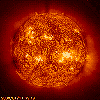| . |  |
. |
|
"The solar magnetic field and the solar wind: Existence of preferred longitudes"  By Marcia Neugebauer, Edward J. Smith, Alexander Ruzmaikin, Joan Feynman, and Arthur H. Vaughan, all at JPL
By Marcia Neugebauer, Edward J. Smith, Alexander Ruzmaikin, Joan Feynman, and Arthur H. Vaughan, all at JPLJournal of Geophysical Research, Volume 105, pages 2315-2324, 2000 Pasadena - February 1, 2000 - Like the Earth, the Sun has a magnetic field whose north and south poles are tilted away from its rotation axis. The solar magnetic field reverses (the N pole becomes a S pole and vice versa) approximately every 11 years (the solar cycle). The solar wind carries part of the Sun�s magnetic field into space, so measurements of the solar wind tell us something about what�s going on inside the Sun where the field is generated.
New Result The study showed that each time the Sun�s field reverses, there is a statistical preference for it to return to the same longitude. Averaged over many years, the interplanetary magnetic field lines tend to point out of one side of the Sun (the Sun�s Eastern hemisphere, say) and point in on the other side (or hemisphere), reversing the pattern approximately every 11 years. This is called a "preferred longitude" effect. The existence of a preferred longitude effect in the Sun had not established, although the possibility had been suggested by studies of the surface of the Sun and of some similar stars. Another way of looking at this result is that as the Sun rotates, the same magnetic structures have tended to face the Earth every 27.03 days (27 days and 43 minutes) over the last 38 years. It has been known for well over a century that some terrestrial phenomena related to the solar wind, such as auroras and geomagnetic storms, tend to recur approximately every 27 days, especially during some phases of the solar cycle. What was not known was that these 27-day recurrences of solar wind properties kept in step from one solar cycle to the next and that the period was really 43 minutes longer than 27 days. Why did it take so long to discover this periodicity? Because it is a very subtle statistical effect. There are many larger variations in the solar wind that come and go, so that the underlying periodicity was largely masked. The 27.03-day periodicity often can�t be seen if the data are examined only a few months or a few years at a time.
Implications Physicists have struggled for years to understand how the solar dynamo generates and maintains the Sun�s magnetic field. These new data must now be taken into account in their theories. The existence of preferred longitudes suggests that the dynamo may operate further below the Sun�s surface than previously thought. Present theories place the dynamo near the bottom of the Sun�s outer zone which transfers heat outward by convection and where time scales or memories of past magnetic structures are fairly short. The persistence of preferred longitudes means that some of the Sun�s magnetism may arise in or be affected by the deeper, radiative zone of the Sun where time scales are longer. Earth�s magnetic field also reverses, on a much longer and very irregular time scale � consecutive reversals are spaced between 5 thousand and 50 million years apart. The preferred longitude effect reported for the locations of the terrestrial magnetic poles have been a puzzle. It might be explained as evidence for some sort of internal structure (such as an irregularity on the core-mantle boundary) or an aspect of the internal dynamo that allows it to "remember" some longitudinal feature in spite of the reversals. Since the interiors of the Sun and stars are so different from the interior of a planet like the Earth, the correspondence is even more puzzling.
SOLARSTORMS AT TERRADAILY.COM
|
| |||||||||
| The content herein, unless otherwise known to be public domain, are Copyright 1995-2016 - Space Media Network. All websites are published in Australia and are solely subject to Australian law and governed by Fair Use principals for news reporting and research purposes. AFP, UPI and IANS news wire stories are copyright Agence France-Presse, United Press International and Indo-Asia News Service. ESA news reports are copyright European Space Agency. All NASA sourced material is public domain. Additional copyrights may apply in whole or part to other bona fide parties. Advertising does not imply endorsement, agreement or approval of any opinions, statements or information provided by Space Media Network on any Web page published or hosted by Space Media Network. Privacy Statement All images and articles appearing on Space Media Network have been edited or digitally altered in some way. Any requests to remove copyright material will be acted upon in a timely and appropriate manner. Any attempt to extort money from Space Media Network will be ignored and reported to Australian Law Enforcement Agencies as a potential case of financial fraud involving the use of a telephonic carriage device or postal service. |